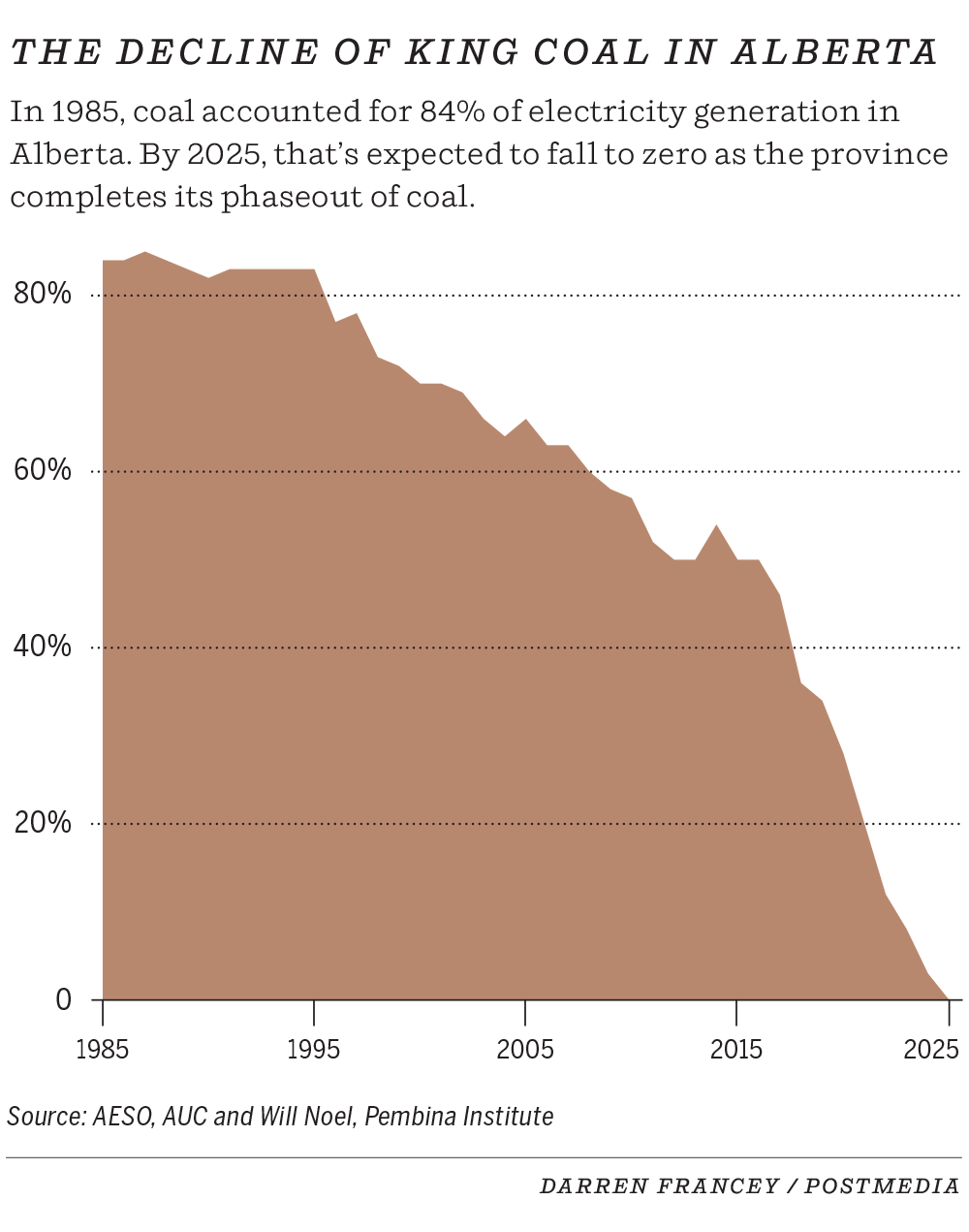Alberta’s electricity grid is expected to fully wean off coal this summer, six years ahead of schedule — a remarkable climbdown from the energy source that 10 years ago provided Albertans with more than half their electricity.
The milestone has even surprised one of the economists who designed Alberta’s coal phaseout plan less than a decade ago.
In recent months, the province has experienced several hours in which coal has been completely absent from its electricity mix.
Alberta’s first coal-free hour came on Feb. 2 and lasted 11 hours.
It happened again in early March, with the province’s final two coal plants producing zero energy for nearly 48 hours between March 4 and 6, according to the Alberta Electricity System Operator’s (AESO) metered volume data.
The final step will come this summer when Capital Power’s Genesee 1 and 2 plants finish transitioning two coal-fired plants to natural gas. (The final plant, Genesee 2, is scheduled to shut down at the beginning of June.) As it stands, coal provides a maximum capacity of just 820 megawatts (MW) — less than four per cent of all available generation in Alberta, a steep decline from a decade ago, when coal provided 5,509 MW and 54 per cent of Albertans’ electricity needs.
“It wasn’t long ago that 80 per cent of electricity supply in Alberta came from coal; now we are starting to see hours where there is zero coal-fired generation in the province,” Blake Shaffer, electricity expert and economist at the University of Calgary, said in an email to Postmedia.
Alberta had 18 coal-fired plants in 2016. At the time, Alberta produced more coal pollution than all other Canadian provinces combined.
‘Arguably the largest emissions-reduction policy in Canadian history’
This year’s phaseout is being celebrated as the result of policy introduced under Rachel Notley’s NDP government, and continued by successive UCP governments.
“I think it’s arguably the largest emissions-reduction policy in Canadian history,” said Andrew Leach, economist at the University of Alberta. Leach chaired Notley’s climate leadership panel when the NDP was in government from 2015 to 2019, and led the design of Alberta’s coal phaseout plan.
Part of that was due to Alberta’s industrial carbon pricing framework, currently known as its Technology Innovation and Emissions Reduction Regulation (TIER). The policy resulted in heavy emitters such as coal plants paying significantly more for their pollution than lower-emitting energy producers, with costs increasing each year.

Adam Gaffney, manager of generation forecasting and resources adequacy at AESO, said the carbon pricing system was the “big driver” that got Alberta off coal.
Despite setting a 2030 full phaseout target, Leach said he was struck by how quickly companies such as ATCO, Capital Power and TransAlta announced the costly endeavour of transitioning operations to natural gas. (The Genesee repowering project, for context, was last projected to cost $1.35 billion.)
“This was by no means a conservative target at the time. I thought it was a very aggressive target,” Leach said. “The real shock for me probably came five years ago, when it became pretty clear that we were going to be off coal . . . much more rapidly than anyone thought.”
Coal phaseout ‘a fantastic case study of really good policy design’
Jason Kenney’s UCP government solidified the NDP’s industrial carbon pricing regime with its TIER system, Leach said.
The effort rivalled Ontario’s 11-year coal phaseout, completed in 2014. In 2003, coal provided a quarter of Ontario’s electricity supply.
“It’s a fantastic case study of really good policy design in that we set a target requiring all the coal plants to go away, but then we set up this economic backing, setting a price signal to allow companies to do it in their own way,” said Will Noel, electricity analyst at the Pembina Institute, a clean-energy think-tank.
The transition comes with major emissions-reduction gains: Getting off coal will reduce Alberta’s electricity emissions from about 50 megatonnes (MT) in 2005 to 16.5 MT projected for this year, according to AESO.
For context, Canada’s entire electricity grid produced 52 MT of emissions in 2021, according to the federal Ministry of Environment and Climate Change.
It also comes amid a surge in renewable power in Alberta.
“We thought it was pretty cool how . . . (last year) we were having hours where solar was producing more than coal for a couple hours at a time,” Noel said. “Only a year later, we’re having zero coal.”
— With files from Postmedia
X: @mattscace67
-
 Alberta coal mine moves ahead without permits federal officials say are needed
Alberta coal mine moves ahead without permits federal officials say are needed -
 Country star Corb Lund criticizes Alberta minister over coal application support
Country star Corb Lund criticizes Alberta minister over coal application support -
 Alberta energy regulator accepts Rocky Mountain coal mine application, public hearing planned
Alberta energy regulator accepts Rocky Mountain coal mine application, public hearing planned
You can read more of the news on source




